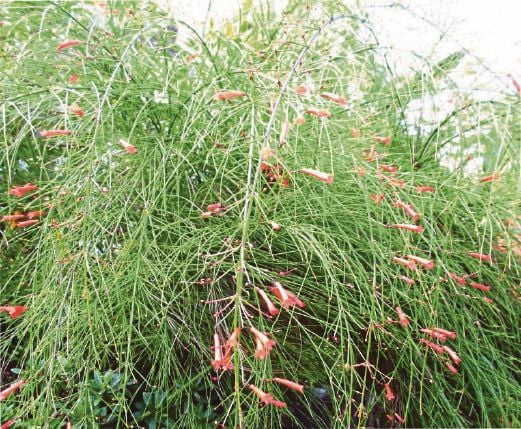

With its bright red tubular blooms, the Russelia equisetiformis is a spectacular sight, writes Stephanie Choo
RUSSELIA equisetiformis has ever-blooming, nectar-rich and firecracker-like flowers that not only make a patch attractive and colourful but are also captivating to bees, butterflies and even birds.
The bush bursts forth in foliage and blooms, creating a spectacular sight very much like a fountain or waterfall.
PLANT FACT
The species is sometimes referred to as Russelia juncea. In Malay, it is Ruselia letup-letup while in Thailand, it is known as Prathat Chine or Russelia. Others call it Coral Fountain, Coral Water Fall or Coral Bush.
A native of Mexico, Russelia equisetiformis is a member of a family of flowering plants known as the figwort family, Scrophulariaceae. The genus name honours the Scottish naturalist and physician, Alexander Russell (1715-1768).
The species name means “like Equisetum” as the plant has the same form as the Horsetail plant, Equisetum.
The bright red two-lipped, tubular blooms that grow at terminal ends of branches are small and only about 2.5cm long. There is a variety that produces creamy yellow flowers and another, pale pink. As they resemble firecrackers, the plant is also commonly known as Firecracker Plant or Firecracker Fern. Seeds are tiny and inconspicuous.
The perennial grows to about a metre high and wide. It is fast growing, multi-branching and short. Its long and slender angular stems grow out arching first and then gracefully cascade down to form a mound. Like the Horsetail plant, the scale-like leaves are so small that you will not notice them.
Other than ornamental value, the plant has medicinal properties — anti-inflammatory, analgesic and antimicrobial. Traditional healers in Nigeria treat diabetes, cancer and inflammatory diseases with the plant. The methanol extract from the plant promotes hair growth while the extract from its leaves and stems is used to make soaps and bath products.
LANDSCAPE USE
The dense wispy weeping growth habit of R. equisetiformis makes it a good choice for an informal or unclipped hedge. When there is wind, the wiry branches will sway but they will not break. They create the much desired movement in the hot garden for a breezy effect.
Movement commands attention. Pollinators going for the nectar add movement and life to the garden.
This finely textured plant works best in tall large containers and hanging pots. Allow the foliage to spill over and soften edges of the pot. The bush can be grown as a specimen, tall ground cover, border, cascading down a wall or on a raised bed or a flowering accent.
PLANT CARE
Grow in full sun or partial sun patches in well-draining, rich soil. Keep plant well hydrated by watering daily. Do not let soil dry out.
Due to its droopy and long stems, if planted in pots, suspend it or choose tall heavy pots. Ensure pots are hung securely and that those on the floor do not tumble. If mass-planted, space each plant about one metre apart.
Once established, the bush has a weedy side. When the stems touch the ground, they will take root quickly. To prevent this, cut back every now and then to keep it looking fresh and neat. The seeds simply self-sow. You can deadhead plant to stop unwanted seedlings production.
Feed regularly with organic goat fertiliser or any balanced liquid fertiliser. Let it grow freely or tie the bush with a stake or trellis to let it flourish taller.
It can be easily propagated using its stem cuttings. Take stems of about 12cm long and insert about half the length of the cutting into some damp clean crumbly soil.
TIP
R. equisetiformis grows well in tight spaces like vertical wall pocket planters as it can be kept to stay small and compact.
It is a great candidate for bog gardens. Grow around the pond as it doesn’t mind wet soil.